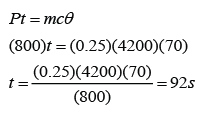- The electric power, P is defined as the rates of energy that supply to the circuit ( or the rates of work been done ) by sources of electric.
- The unit of electric power is the watt (W).
- One watt of power equals the work done in one second by one volt of potential difference in moving one coulomb of charge.
- The electrical power of an electric circuit component can be find from the following equations:
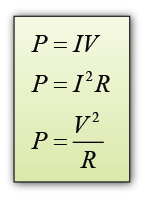
Where
P = power/4
t = time
I = current
V = potential difference
R = resistance
Example 1:
A current of 0.50A flows through a 100Ω resistor. What is the power lost in the resistor?
Answer:

Example 2
An electric iron has a heating element of resistance 50Ω. If the operating current flowing through it is 4A, calculate the heat energy produced in 2 minutes.
Answer:
Power of the iron,

Heat energy produced,

What is the power dissipated in a 4Ω light bulb connected to a 12V battery? What is the power dissipated in a 2Ω light bulb connected to the same battery? Which bulb is brighter?
Answer:
Assume that the bulbs are resistor

Power dissipated in the 4Ω resistor,

Power dissipated in the 2Ω resistor,

The power of the 2Ω bulb is higher, hence it is brighter.
[Conclusion: The lower the load resistance in a circuit, the greater the power dissipated in the circuit]

An ideal battery with e.m.f. 12 V is connected in series to two bulbs with resistances R1 = 4Ω and R2 = 2Ω What is the current in the circuit and the power dissipation in each bulb?
Answer:
Potential difference across the 2 resistors, V = 12V
Equivalence resistance of the 2 resistors, R = 4 + 2 = 6Ω
Current in the circuit,

Power dissipated in R1

Power dissipated in R2

[Conclusion: In a series connection, the greater the resistance of a resistor, the greater the power dissipated]
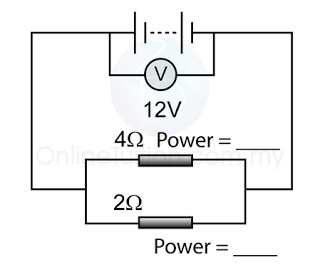
The figure above shows that an ideal battery is connected in parallel to two resistors with resistances 2Ω and 4Ω. Find the power dissipated in
a. the 4Ω resistor
b. the 2Ω resistor
Answer:
a. The potential difference across the 2 resistor = 12V
The power of the 2Ω resistor,
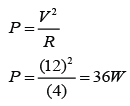
b.
The power of the 4Ω resistor,

[Conclusion: In a parallel connection, the lower the resistance, the greater the power of the resistor.]
2 identical bulb of resistance 3Ω is connected to an e.m.f. of 12V. Find the power dissipated in the circuit if
a. the bulb is connected in series
b. if the bulb is connected in parallel
Answer:
a.

Current pass through the 2 resistors,

Power of each of the resistor,

Sum of the power,

b.
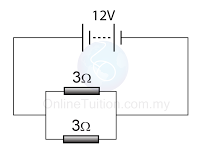
Potential difference across the 2 resistor = 12V
Power of each of the resistor,
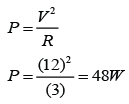
Sum of the power,

Example 2:
A 800W heater is used to heat 250 cm³ of water from 30 to 100°C. What is the minimum time in which this can be done? [Density of water = 1000kg/m³; Specific Heat Capacity of water = 4200J°C-1 kg-1]
Answer:
Energy supply by the heater, E = Pt
Heat energy absorbed by the water, E = mcθ
Let's assume that all the energy supplied by the heater is converted to heat energy and absorbed by the water, hence
